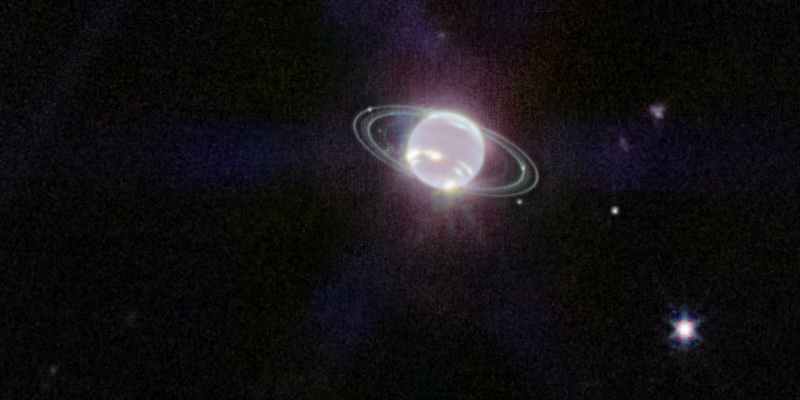The James Webb Space Telescope (JWST), the largest and most powerful space telescope ever made, has observed Neptune in the greatest detail among observations made in the past 30 years. The image clearly shows the rings around the celestial body and the characteristics of the icy atmosphere surrounding it, with the highest clouds at -200 ° C.
The eighth and farthest planet in the solar system, starting from the Sun, Neptune has a mass 17 times the mass of Earth and is considered an “ice giant”, with a different composition from other large gaseous planets such as Jupiter And the Saturn. In addition to hydrogen and helium, two elements common to the largest planets in the solar system, Neptune contains greater amounts of ammonia and methane, while the interior of the planet is mostly made of rocks and ice. Traces of methane in the upper layers of the atmosphere help make Neptune appear a somewhat darker blue.
However, in the JWST image, Neptune does not appear blue as we expect, because the telescope is detecting infrared radiation, which is the part of electromagnetic radiation that we can’t see because its frequency is lower than that of visible light. Infrared allows us to better understand details and differences that might otherwise be invisible, such as the properties of Neptune’s atmosphere.
With the average distance between the Earth and the Sun about thirty times, Neptune is located in the farthest part of the Solar System and receives very little light. In daylight, the planet has a brightness comparable to that of the Earth’s aurora. It is this large distance that partly determines the very low temperature of Neptune’s atmosphere and makes it a “frozen giant”.

(NASA, ESA, CSA and STScI)
In the JWST image, frozen methane clouds in the outer layers of the atmosphere are clearly visible, appearing much lighter than the rest because they reflect sunlight. A slight lighter line can also be seen along the equator, indicating atmospheric currents hitting Neptune. In the equatorial belt, the atmosphere is relatively warmer and therefore appears brighter than in other regions of the planet. Glow can be seen near the North Pole, as well as in the Antarctic region, where the long-known atmospheric vortex is concentrated.
The planetary ring system is among the thinnest in the Solar System and there are various hypotheses about its composition and properties. The earliest observations were made in 1989 by the Voyager 2 probe, which for the first time confirmed the existence of multiple rings. The probe images allowed confirmation of the presence of five main rings, with an irregular structure probably due to gravitational interactions with many of the planet’s satellites.

(NASA, ESA, CSA and STScI)
It takes Neptune 164 Earth years to complete a full orbit around the Sun, but in the long journey it is accompanied by at least 14 moons, which have been observed and cataloged over the years. Most visible in the JWST image is Triton, Neptune’s largest natural satellite. The surface of this moon is made mostly of frozen nitrogen and reflects 70 percent of the sunlight that reaches it. It is precisely this circumstance that makes Neptune brighter in the infrared.
JWST sends data on brightness and light captured by its sensors to the Space Telescope Science Institute (STScI), which does an initial processing by providing files that can then be used by astronomers for their studies and analysis. Space objects can be observed in the infrared using various filters, which are calibrated to capture specific wavelengths. So you can to score Each filter is equivalent to the cutoff that our eyes can see. What has a longer wavelength – again in infrared – can be translated to red, for example, while what has a shorter wavelength is translated to blue. By doing this, we can take radiation from a part of the spectrum that our eyes cannot see and move it to the part that is visible to us. It’s a bit like raising or lowering the tone of a song, so to speak.
Depending on the needs, this technique is used to highlight some elements and characteristics at the expense of others. The image of Neptune has been calibrated to show the characteristics of the planets’ atmospheres and their faint rings. The data collected by JWST, which will be enriched in the coming years with the observations of some of the planet’s moons, will allow new studies and research to be carried out on the most distant member of the family of planets that make up the Sun. the system.

“Unable to type with boxing gloves on. Freelance organizer. Avid analyst. Friendly troublemaker. Bacon junkie.”



